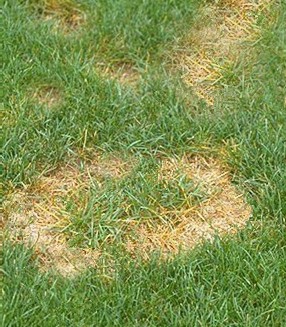Brown Patch Fungus Fescue Lawn
Low-maintenance, cool-season fescue grasses (Festuca spp.) grow well in shade and can grow in U.S. Department of Agriculture plant hardiness zones 3 through 11. Many tall fescue (Festuca arundinacea) varieties are used as lawn grasses and grow well in USDA zones 4 through 9. In summer, when nighttime temperatures are above 65 degrees Fahrenheit, accompanied by wet weather, fescue grass, especially tall fescue, may develop yellow or brown patches of dead grass. Often, the damage is due to 'brown patch,' a disease caused by the fungus Rhizoctonia solani.

Other grass molds, including pythium blight, gray leaf spot and rust, are caused by different fungi with symptoms that resemble those of brown spot. You can control the mold with the right care. Watering Fescue Brown patch and other fungi need moisture to grow. Heavy dews, fog and rain encourage the growth of grass molds. Watering too much is more likely the cause.
Water fescue lawns only once every five to seven days. A fescue lawn only needs 1 to 2 inches of water per week, whether from rain or watering. Water fescue only in the morning or in the early afternoon to make sure water evaporates from the grass blades during the day. Molds will not infect and grow on dry grass blades.
Jul 11, 2013 Extremely wet grass promotes fungus growth and can actually harm your lawn. Bernard Burnes Managing Change 5th Edition more. Here are 8 ways to treat brown patch and. Signs of brown patch or fungus. The disease brown patch can be trouble in tall fescue. This article discusses managing brown patch and a Kansas State study done this disease. Brown Patch in Tall Fescue Lawns: Information for Homeowners By Megan Kennelly, KSU Plant Pathology. Difference Between Selection And Subselection Tool In Flash. Brown patch, caused by the fungus Rhizoctonia solani,is common.
Dethatch and aerate your lawn to improve soil drainage so the grass stays dry. Applying Fungicides If changing your watering and fertilizer schedules don't help, you may need to use fungicides. Newly seeded lawns and lawns that had brown patch in the past benefit from fungicide treatment. Mow the lawn before applying fungicides and let the fungicide dry before watering. Preventive fungicide treatment of fescue lawns at risk for brown patch and other grass molds works better than treating lawns that are already diseased.
Plan to apply the preventive treatment when wet weather and nighttime minimum temperatures above 60 degrees Fahrenheit are forecast. Apply a fungicide, such as propiconazole, at a rate of 2 to 4 ounces in 2 to 5 gallons of water for each 1,000 square feet of lawn before brown patch symptoms appear and repeat every two to four weeks. Alternatively, apply 1 to 2 ounces of the fungicide triadimefon in 2 to 4 gallons of water for each 1,000 square feet of lawn every two to four weeks or more often if grass mold has already taken hold. Always wear long pants, long sleeves and sturdy shoes when working with garden chemicals. Keep children and pets out of the area while you spray and follow all safety instructions on the label. Double-check rates and application methods because they vary by brand.
Choosing Fescue Varieties and Mixes Use newer varieties of fescue grasses with greater resistance to fungal diseases when overseeding fescue lawns. Examples of tall fescue varieties with good resistance include 'Apache III,' 'Finelawn Elite' and 'Hounddog 6.' A blend of fescue seed varieties with different grass mold resistance ensures a better looking lawn if your lawn becomes infected. Seed mixes containing small percentages of non-fescue grass seeds can also improve lawn quality and reduce the severity of disease.
Treating an Active Infection Apply a fungicide with the active ingredient Chlorothalonil (such as Daconil), which will kill brown patch fungus on contact. Another effective fungicide is Terraclor, whose active ingredient is Pentachloronitrobenzene. Best practice is to perform two or three treatments each seven days apart. Apply fungicide not only to the visibly affected areas, but also to the five or six feet surrounding the damage.
Treatments will not restore green to the brown patches on your lawn, but they will beat back the fungus so that your lawn can begin to recover. Do not fertilize your lawn until after the final fungicide treatment. Afterwards, be careful not to over-fertilize. Give your lawn only a very light fertilizer application to aid in its recovery. During an outbreak, don't mow when the grass is wet, and don't leave grass clippings on the ground. The clippings will be full of the brown patch fungal spores and will reinfect your lawn.
You may resume mulch mowing after successful treatment is concluded. Preventative Fungicidal Application Use Bayleton (Fung-Away) slow release formula to prevent brown patch in lawns that have had past outbreaks or are in a region that is susceptible to brown patch outbreaks. Apply at least a week or two before the season of greatest vulnerability to brown patch and reapply throughout the growing season.